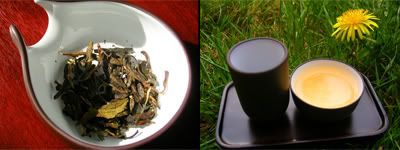
15cl shengpu pot; Caledonian Springs @ 100C; 1 rinse. Stephane recommends longer infusion times for this. 2 scoops.
Leaves:
The compression of this bing must have been loose, as this looks like maocha. Some dark leaves, some green, with a few silver tips. It looks very decent indeed, with long sections of leaf and robust colours. The aroma is energetic.
15s, 20s, 25s, 35s, 50s:
Very clean yellow soup, with a fair quantity of fur testifying to the tippiness. Long, zesty, and fresh in the wenxiangbei. A little more brown in colour, when poured into the pinmingbei. I am pleasantly surprised to see that I have slightly underbrewed this young leaf - usually the reverse is true for young shengpu, leaving a bitter first infusion.
It is smooth, flavoursome, with a well-balanced ku at the end. Remarkably, it is almost effervescent on the lips, tongue, and cheeks. Very pleasant, very bright. My mouth is buzzing from energy: I can feel a low-amplitude, high-frequency vibration.
Used leaves:
Luxurious. Up to 10cm in length, and largely whole, these leaves feel like silk. The spring leaves are often thin, and this tea is no exception. The colour is fine. Two types of leaves appear to form this tea: some are perfectly smooth at the edge, while others are serrated (see photograph below - click for an enlargement).

Overall:
A very fine young shengpu, with enough punch to perhaps indicate potential for aging. The most remarkable aspect of this tea is the vibrant energy felt throughout the mouth.
It is a robust and stable tea, not varying in any great extent over the course of the session. Refreshing, enjoyable, and well-made - but by whom?
I don't feel confident in being able to define the Lincang terroir, but we enjoyed getting a step closer.

2 comments:
Thank you for that well written tasting note. I believe you have tasted the truly 'wild' and pure character of this puerh. It is made from wild trees that grow over 2000 meters altitude.
Also, because this is not a mix, it doesn't have multiple tastes and fragrances, but unity and 'stability', as you put it.
I'm glad you liked it, because this is one of the best young raw puerh I've ever tasted.
I would say the Lincang terroir is very sweet, but less fruity than Yiwu, and it has more length and cha qi.
Dear Stephane,
As usual, thank you for the additional information - one can never know too much about the tea's particulars. It certainly is fine, as you say. Definitely one for enjoyment now as well as later.
Toodlepip,
Hobbes
Post a Comment